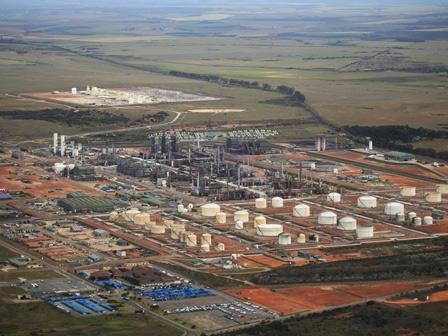NOTE: The sponsor of this content may contact you with more information on this topic. Click here to opt out from sharing your email address with this sponsor. (This link will not unsubscribe you from the BIC Magazine Industry Connection e-newsletter or any other BIC email list).

Tank farm operators face many challenges; high among them is the compatibility of the vessel with an ever-widening range of compounds. For example, a tank lining selected to resist light oils is not necessarily compatible with alkylates.
When PetroSA’s Mossel Bay facility, one of the largest gas-to-liquid (GTL) processing plants in the world, was faced with a demand for increased tank capacity, they determined that a major concern impacting capacity and tank availability was the suitability of the installed corrosion-resistant linings for the intended process stream.
With a total capacity of 36,000 bbl./day, the plant uses the Fischer-Tropsch process, which converts natural methane-rich gas into ultra-clean, low-sulphur, low-aromatic synthetic fuels and high-value products such as unleaded petrol, kerosene (paraffin), diesel, propane, liquid oxygen and nitrogen, distillates, eco-fuels, process oils and alcohols. Historically, many of the tanks had been lined with coating systems optimized for a specific chemical but not generally suited for the wider range of intermediate and finished products being processed. To maintain tank integrity, many tanks were also being relined every three to five years due to premature failure. The cost to isolate, drain, clean and ventilate gas free, prepare the surfaces and apply/cure a lining system to a mid-size tank is typically $150–200K. Factoring in a five-year life, the invested asset would depreciate at a rate of $40,000/year. Due to these high costs, the plant decided to see what other lining options were available to increase the mean time between failures (MTBF) for lined surfaces of tanks. At the same time, they wanted greater tank capacity to improve the ability of the lined systems to handle a wider range of intermediates and finished goods.
In 2001, the plant began an evaluation to determine the suitability of various linings for multiple exposure conditions. Multiple protective lining suppliers were evaluated based on their standardized testing as well as “in field” references and trials. One of the more popular qualifying tests used is NACE TM 0174, issued by the National Association of Corrosion Engineers. This test simulates a tank wall exposed to immersion and vapor phases under atmospheric pressure. The test also allows for temperature control of the test solution as well as the temperature differential, ΔT, between the solution/vapor and the exterior of the tank, which can impact permeation rates. Since the plant manager was interested in being able to support intermediates as well as storing finished goods, a wide range of test conditions were considered with acids, bases, light and heavy hydrocarbon distillates, and water at varying temperatures.
Another qualification test that was considered included assessing the aging effects of mechanical property retention after extended chemical exposures. Samples were immersed in process streams. After a period of 30-60 days, they were removed and tested against a control to determine what, if any, reduction occurred in the tested sample. Critical values tested were tensile adhesion, tensile elongation, the flexural modulus of elasticity, and dielectric breakdown. After extensive testing and technical submittals the client selected four systems from one supplier that could handle the widest range of anticipated process streams. Numerous suppliers offered alternatives but when concerns surrounding a 10-year warranty clause in the supply contract arose, all but one supplier bowed out of the race.
The testing indicated that one supplier could offer two lining systems that would cover the widest possible range of exposures. The first tanks coated were a series of alkylate tanks (S7 TNK 125A+B) in 2003. These were lined with ARC S4+, a 100% solid, airless spray-applied, mineral glass flake reinforced, multi-functional novolac epoxy, manufactured by the A. W. Chesterton Company. The lining system was applied by the manufacturer’s qualified applicator and underwent inspection at the conclusion of the initial warranty (nine years and 10 months). At that time, the alkylate tanks were opened and inspected by the facility owner and also by the various lining suppliers who had initially bid on the project. The lining system was in perfect condition with no signs of distress and the tanks were returned to service.
In 2006, the second series of tanks to be lined under this expanding program included flare knockout vessels, reaction wastewater and treated wastewater tanks. Once again, qualification testing and the required issuance of a performance warranty negated several suppliers from submitting bids. The selected lining system was ARC S2, a spray-applied, cycloaliphatic amine cured, novolac/Bisphenol A, ceramic reinforced, 100% solids epoxy. Similarly, these tanks and vessels were inspected at the conclusion of the initial 10-year warranty period. The linings were found to be in excellent condition and the tanks have been returned to service.
The final series of tanks to be lined occurred between 2009 and 2016. Synthetic light oil tanks were lined with the same system used in the alkylate tanks and demineralized water tanks were lined with the same system used in the reaction and treated wastewater tanks. In addition, since 2003, over 200 heat exchanger water-boxes and tube-sheet plates have been coated with the same system used for the demineralized water, reaction and treated wastewater tanks.
According to Petro SA’s on-site Mechanical Engineer Johan Gerber, the investments made have saved in excess $1.7 million over the initial 10-year warranty period, in large part by negating intermittent inspection and relining. Additionally, the tanks have been able to accept various intermediate process streams, thereby increasing plant capacity and production output. Through a rigorous qualification process backed up by standardized testing and controlled field trials, this facility has been able to more fully utilize their fixed tank assets for multiple process streams, allowing optimization and increased plant output.
